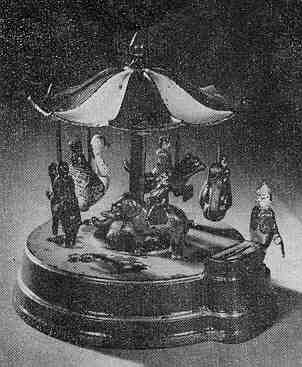Merry-Go-Round Bank
by F.H. Griffith - HOBBIES Magazine - December, 1951
 If there is anything that can take a person back to their
childhood quick as a flash certainly the sight of a merry-go-round does just that, and
apparently this is an outstanding point contributing to the desirability of the
Merry-Go-Round Bank. Its nice action coupled with its attractive appearance and rarity
rank this bank in the third position.
If there is anything that can take a person back to their
childhood quick as a flash certainly the sight of a merry-go-round does just that, and
apparently this is an outstanding point contributing to the desirability of the
Merry-Go-Round Bank. Its nice action coupled with its attractive appearance and rarity
rank this bank in the third position.
It is not definitely known as yet what company manufactured the bank, however it is interesting to note that the same type of four-leaf clover perforated casting is used in the base plate on the Roller Skating Bank, the Confectionery Bank and the Merry-Go-Round. Also the same type solid figures appear both on the Merry-Go-Round and the Roller Skating Banks. There is no definite information on the Roller Skating Bank either, however it is known that the Confectionery Bank was manufactured by Kyser and Rex in Philadelphia, Pennsylvania, and with the above similarity between the three it is fairly reasonable to assume that they manufactured the Merry-Go-Round and further that it was designed by R.M. Hunter. The bank was probably made in the 1880’s.
The particular bank pictured was obtained through L.C. Hegarty, well known collector, who in turn obtained it from A.W. Pendergast.
The bank operates as follows: First a coin is inserted in the slot beside the small man with whip in hand, then a crank is turned and the man moves back and forth as though whipping the animals or knocking the coin in the bank. The coin actually drops in automatically. As the crank is turned the animals suspended from the canopy revolve and a bell rings. The colors are quite bright and gay, the canopy being red, white and blue and the base is red, gold and tan, while the animals and figures are painted in natural colors. It is interesting to note that the animals consist of an elephant, a camel, a swan, a pony, and an ostrich which is significant because the older, better type merry-go-rounds consisted of different animals rather than just horses.
It might be well to point out at this point in these articles that the desirability or value of a mechanical bank is not necessarily governed by its age or rarity. As example, there is only one known specimen of Little Moe but its value does not compare with the Harlequin of which at least six are known to exist. As further example, the Halls Excelsior Bank dated 1869 is the earliest known dated cast iron bank but at the same time the most common and least expensive to purchase. The value and desirability is further enhanced by the action, the subject of the bank and then, of course, its general condition as to paint and proper operation.
